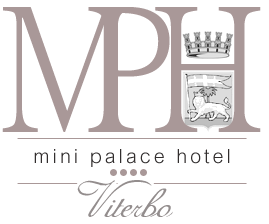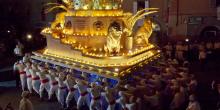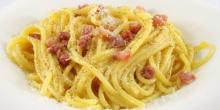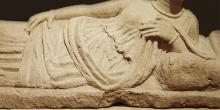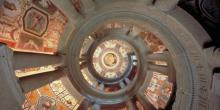Every year on the night of September 3rd, this Macchina is picked up and carried on the shoulders of a hundred men who are called the “Facchini of Santa Rosa” along the long and narrow streets of the city, all the way to the main piazzas of the center. During this procession, which begins at 9 pm and it is witnessed by thousands of people, the lights of the streets are lowered, in order to make the light of the Macchina stand out. This religious event symbolically recalls the transfer of the body of Santa Rosa, occurred in Viterbo in 1258 according to Papa Alessandro IV’s orders, from the Church of Santa Maria in Poggio (also known as Crocetta) to the Church of Santa Maria delle Rose (today called the Sanctuary of Santa Rosa). The celebration is part of the network of the italian piece brought on shoulders, and in 2013 it was inserted in the heritage list of UNESCO as one of the intangible and oral traditions of humanity. The Terme
The Terme dei Papi The Pope’s Thermal Baths of Viterbo are the most frequented ones of the entire region of Lazio. Esthetic and dermatological cures, inhalation, thermal mud treatment, hydrojets and nutrition classes are just a few of the many wonderful activities offered at the Terme dei Papi, along with an efficient organization and punctual service. The Terme dei Papi were already known from the Etruscan times for its therapeutic and spiritual properties, and they were valorised particularly from the Romans and still today offer a delightful moment of relax and health. The elevated temperature of the Baths waters make it possible to use even during the winter. In 1994 the Terme dei Papi completed their restoration project and an extension of the new thermal complex.
It is defined “poor and mediterranean”, mainly because the ingredients of the area are healthy and genuine, such as the extra virgin olive oil, vegetables, legumes and cereals. From the various flavoured bruschetta toast, salamis, pizzas, and other typical food. You can almost smell and taste the vegetable garden in the many different dishes such as acquacotta (typical soup with cicory, potatoes, tomatoes, onions, mint and chili pepper, with the addition of salted codfish and eggs), sbroscia (soup with cicory, potatoes, tomatoes, onions, mint and chili pepper, with the addition of salted codfish and eggs), scafata (soup with fava bean and bacon), pezzate (soup with lamb meat), pignattaccia (stew with pieces of meat and vegetables), snail soup, etc.Featured in the main courses are the traditional maccaronis and ceciliani of Canepina, fettuccine with mushrooms from Tarquinia, lombrichelli (pasta made with water and flour), pappardelle with hare, rigatoni with pagliata, potato gnocci and broth. Pasta with beans, chickpeas, pasta with potatoes, rice and lentils. The second courses mainly consist of meat which you can find on all the grills of the city (lamb chops, skewer pork, steak of the Maremma area) and in scented pans like chicken with tomatoes, rabbit and lamb alla cacciatora, boar at Bujone. We must not forget the porchetta and the tripe with sauce!
First of all, Tarquinia is the Etruscan necropolis’ (only a few of the tombs are visible) famous for the frescos on the walls (VI-II century BF) that portray scenes of life of the dead person: hunting, feasts, dances, games, animals, demons and more. In Tuscania we can find the sarcophagus of Curunas (IV-II BF), in Vulci it is possible to see bronze. The rocky necropolis of Blera, Barbarano Romano, Norchia and Castel D’Asso are prudently accessible: the tombs are dug in the natural tufo limestone and are mostly enclosed in the dense vegetation. The ruins of the Roman theatre are noticeable in Ferento and in Faler Novili you can find the cyclopic walls of the old habitation that was destroyed and abandoned during Medieval times.
Places of faith
It is interesting to observe the romantic churches of Tuscania (Saint Peter and Saint Maria Maggiore), which are considered masterpieces of the Paleochristian art. The abbey of San Martino al Cimino is an impressive church of Viterbo and dates back to the Cistercians of Pontigny. Other important churches are the highmedieval ones of Viterbo (San Sisto, San Giovanni in Zoccoli, and especially Santa Maria Nuova) and the ones of San Flaviano in Montefiascone, Santa Maria in Castello in Tarquinia and San Francesco in Vetralla. The sanctuary of the Madonna della Quercia of the Renaissance times is also a refined one (2km from Viterbo). Also the colonnade of the Duomo of Civita Castellana in a Cosmatesque style. Other significant churches to cherish are: Santa Rosa and San Crispino (Viterbo), Santa Cristina (Bolsena), San Bonaventura (Bagnoregio), the Madonna ad Rupes (Caste Sant’Elia) and the Santo Sepolcro (Acquapendente)
The double asterisk is reserved for Viterbo: aristocratic palaces (Priori, Popes, Farnese, Posica, Gatti, Mazzatosta), the particular Medieval neighbourhood of San Pellegrino, almost ten artistic fountains, churches and courtyards of various periods of time, a museum with numerous masterpieces (the Pietà of Sebastiano del Piombo) and a mural wall of the first years of the 1000s, still well conserved. The most important and distinct historical centers are: Tuscania, (rebuilt after the 1971 earthquake), Vitorchiano (the entrance is from one door only), Civita di Bagnoregio (connected to the ground from a bridge suspended above the valley of the Calanchi) Calcata, which has become a place where artists from all over the world stay, Bassano in Teverina (recently restored), Bomarzo (along with the Parco dei Mostri), Orte (located on the valley of the Tiber river), Marta (old town of fishermen), San Martino al Cimino (near Viterbo, it is a jewel of the Roman Baroque style).
Ville e Castelli
Villa Lante in Bagnaia, Villa Farnese in Caprarola and the Parco dei Mostri in Bomarzo: three surprises of the late Renaissance made of gardens, fountains, frescoes and sculptures. Along comes a numerous rank of castles and palaces often reconstructed on pre-existing Medieval methods that belonged to noble lords of the place and princes of the Church: Orsini (Soriano in Cimino and Vasanello), Marescotti-Ruspoli (Vignanello), Monaldeschi (Bolsena), Farnese (Caprarola, Gradoli, Valentano), Borgia (Civitacastellana, Nepi), Odescalchi (Bassano Romano), Albornoz (Viterbo), Santacroce-Altieri (Oriolo Romano). Also important to notice is the massive Rocca dei Papi of Montefiascone and the castel of the Abbadia in Vulci.
